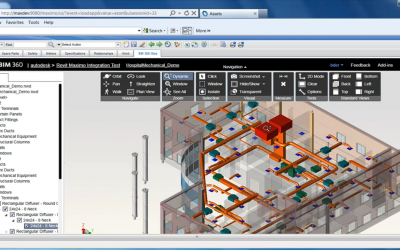Imagine a scenario where a crucial shipment gets delayed because a vital piece of equipment at the seaport malfunctions. The domino effect is significant: frustrated customers, missed deadlines, and potential financial losses. Seaports operate in a high-pressure environment where efficiency is paramount. In the competitive global market, even minor delays can disrupt supply chains and erode customer trust.
This is where IBM Maximo comes into play, providing a powerful solution designed to improve asset maintenance and management. Seaport managers and directors, this blog is specifically written for you, the leaders responsible for optimising seaport operations. You're constantly seeking ways to improve efficiency, minimise delays, and ensure smooth cargo flow. Logistics professionals, if you're involved in the complex world of maritime logistics, you understand the ripple effects of seaport inefficiencies. This blog explores how Maximo can empower you to streamline operations and ensure timely delivery of goods. For anyone interested in supply chain optimisation, this blog provides insights into how Maximo can contribute to a more efficient and resilient supply chain, especially in today's interconnected global economy where efficient seaport operations are crucial.
In this blog, we explore Maximo's capabilities, illustrating its impact through recent research, successful case studies, and expert insights. Join us as we explore how Maximo is raising the bar for seaport operations, making them safer, more efficient, and better prepared to face the challenges of a globalised economy.
The Power of Predictive Maintenance
Enhancing Operational Efficiency
A 2020 report by McKinsey & Company estimates that predictive maintenance has the potential to generate an annual global value of up to $3.7 trillion. This suggests that seaports, with their reliance on a multitude of assets, stand to gain significant advantages by adopting predictive maintenance strategies. This cost reduction underscores the efficiency gains from proactive maintenance. Maximo utilises advanced AI and machine learning models not just to forecast potential failures but also to streamline the shift from preventive to predictive maintenance, heralding a new era of efficiency in seaport operations.
The benefits of Maximo extend beyond cost savings. For instance, Port Taranaki leveraged Maximo to shift from reactive to proactive maintenance, significantly enhancing operational efficiency and resource allocation. This real-world example demonstrates how Maximo empowers seaports to achieve true operational excellence, beyond merely maintaining equipment.
Asset Monitoring and Management with Maximo
Centralised Control and Real-time Insights
Maximo's centralised asset database provides a unified view of all assets, including cranes, forklifts, and straddle carrier. This is crucial for large-scale operations like seaports. Coupled with IoT integration, this system offers real-time monitoring, delivering critical insights into asset performance and health. This integration is pivotal in maintaining high availability and performance, underpinning safety and efficiency across seaport operations. However, obtaining truly real-time data poses its own set of challenges, such as the need for high-speed data processing and robust network infrastructure to handle the vast amounts of data generated by port operations.
"By implementing IBM Maximo, seaports can leverage data-driven insights to optimise maintenance strategies, leading to significant reductions in downtime and improved environmental sustainability." - Dr. Elena Garcia, Professor of Maritime Logistics, Rotterdam School of Management
Reliability Centered Maintenance (RCM)
Streamlining Maintenance Costs and Enhancing Availability
RCM is not just about maintenance; it is about doing so intelligently and efficiently. Maximo's approach includes pre-built best practices and failure mode effects analysis (FMEA), which are instrumental in minimising unnecessary maintenance and focusing efforts where they are most needed. This methodology helps in significantly reducing downtime and maintenance costs while ensuring that equipment is available and reliable when needed most.
Supporting RCM with Maximo
Maximo is adept at integrating predictive maintenance tools that assess and predict potential failures before they occur. This capability ensures that maintenance efforts are precisely timed and executed, maximising equipment uptime and extending asset lifespans—key advantages for busy seaports aiming to avoid operational disruptions.
Ensuring Regulatory Compliance and Enhancing Asset Health
Compliance and Safety
In an environment as regulated as a seaport, compliance with safety and environmental standards is paramount. Maximo supports this by maintaining detailed regulation and compliance records, simplifying audits, and managing permits to work. These features ensure that all operations meet the highest standards of compliance, safeguarding the port and its personnel.
Maximo serves as a centralised repository, maintaining a comprehensive and accurate record of truth for all asset-related data, including maintenance histories, performance metrics, and lifecycle information. This record of truth empowers organisations to make informed decisions, optimise maintenance strategies, and maximise asset performance and longevity. By leveraging Maximo's robust data management capabilities, organisations can establish a single source of truth for their asset management operations, enabling data-driven decision-making and fostering transparency and accountability throughout the maintenance lifecycle.
Health and Criticality Scores
Maximo Health goes beyond standard maintenance practices by evaluating the health and criticality of assets. These metrics guide seaports in prioritising maintenance activities, ensuring that resources are allocated effectively, and managing risks proactively.
Maximo Scheduler: A Tool for Optimal Resource Allocation
Visual Management and Efficient Response
Maximo Scheduler enhances the visual management of resources with tools like Gantt charts and maps, providing clear oversight of maintenance schedules and workforce allocation. This capability is crucial for handling both planned and unplanned maintenance activities efficiently, ensuring that the right resources are available at the right time.
Conclusion
Throughout this exploration of Maximo’s capabilities, we have seen how the software plays a crucial role in enhancing seaport operations. With its advanced predictive and preventive maintenance tools, comprehensive asset management system, and robust compliance features, Maximo not only improves operational efficiency but also sets new standards for asset management in the maritime industry. As we look towards the future, how might your seaport harness the power of Maximo to navigate the challenges of a dynamic global market?



